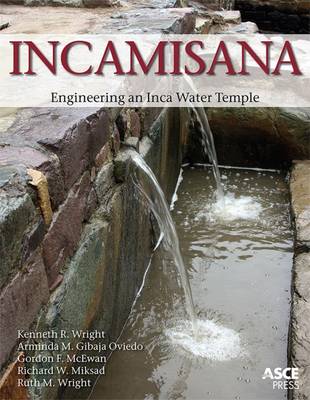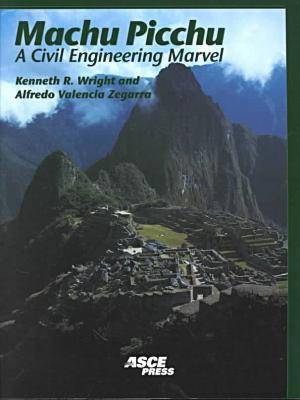Asce Press
3 total works
Incamisana
by Kenneth R. Wright, Arminda Margarita Gibaja Oviedo, Gordon F McEwan, Richard W. Miksad, and Ruth M Wright
Published 13 January 2016
Water and water worship were integral to the spiritual life of the Inca. The Incamisana, an ancient water temple that is part of the royal estate at Ollantaytambo, is a hydraulic masterpiece that serves as historical evidence of the importance of water to the Inca.Preserved under a massive amount of alluvial soil following the 1679 flood, the Incamisana was rediscovered in 1980, revealing a complex water system. The water system of open channels, buried conduits, hydraulic drop structures, eight fountains, and orifices was a well-designed and balanced flow system based on the same engineering principles employed in modern waterworks. Created several centuries before Bernoulli formulated the relationship between flow, energy, and elevation, the Inca were able to control the flow of water with a degree of sophistication that rivals modern engineers.
In Incamisana: Engineering an Inca Water Temple, Ken Wright and his team analyze and explain the masterful design of the temple, which incorporates hydraulic works into an aesthetically pleasing ceremonial complex. Additional studies at the nearby Lip Fountain and Bath of the Princess Fountain further illustrate the engineering skills of the Inca.
Set against a backdrop of impressive and mysterious cliff face rock carvings, the Incamisana is also part of a larger water supply system for the region. Wright's team investigates the mountainside hydrology, geology, and paleohydrology supporting the fountains and the surrounding agricultural terraces necessary to support the Inca community.
Extensively illustrated with photos and drawings, this book provides engineers, archaeologists, tourists, and armchair travelers with an appreciation of the civil engineering skills of the Inca people.
In Incamisana: Engineering an Inca Water Temple, Ken Wright and his team analyze and explain the masterful design of the temple, which incorporates hydraulic works into an aesthetically pleasing ceremonial complex. Additional studies at the nearby Lip Fountain and Bath of the Princess Fountain further illustrate the engineering skills of the Inca.
Set against a backdrop of impressive and mysterious cliff face rock carvings, the Incamisana is also part of a larger water supply system for the region. Wright's team investigates the mountainside hydrology, geology, and paleohydrology supporting the fountains and the surrounding agricultural terraces necessary to support the Inca community.
Extensively illustrated with photos and drawings, this book provides engineers, archaeologists, tourists, and armchair travelers with an appreciation of the civil engineering skills of the Inca people.
Machu Picchu: A Civil Engineering Marvel takes readers inside the Lost City of the Incas for a groundbreaking perspective never before seen by tourists or archeologists. Built high in the Andes on a seemingly impossible site, Machu Picchu stands as a testament to Early Native Americans and their ability to plan and build. How was it possible to create a mountain-top city complete with running water, drainage systems, food production, and stone structures so advanced they have endured for over 500 years? Authors Kenneth R. Wright and Alfredo Valencia Zegarra explain these and other mysteries, based on their original engineering and scientific research. A fascinating book, ""Machu Picchu: A Civil Engineering Marvel"" is a must-have for civil engineers, archeologists, armchair travelers, and tourists alike. An illustrated walking guide and detailed map allow readers to become familiar with each building and pathway, and numerous photographs take readers on a breathtaking pictorial adventure.
Moray
by Kenneth Wright, Ruth Wright, Alfredo Valencia Zegarra, and Gordon McEwan
Published 22 February 2011
Halfway between Machu Picchu and the city of Cuzco, Peru, lies a civil engineering wonder that has captivated and puzzled researchers and travellers since it was first photographed in 1931. Situated on a plateau, the ancient Inca site of Moray consists of many terraced circular depressions in the earth, the largest of which is 30 meters (98 feet) deep. The difference in temperature between the top and the bottom of the circles can be as much as 15 DegreesC (27 DegreesF).
What are the mysterious concentric circles? What do they mean? Was this a religious site? An agricultural research station? Moray: Inca Engineering Mystery reports the results of an exhaustive investigation into the surveying work underlying the site's construction, as well as the engineered systems for collecting and delivering water. Ken Wright and his team take the reader on a tour of Moray, describing the geography and geology of the area. They explain their field evidence that led to solving the Inca mystery and resolving decades of speculation.
The book includes a walking tour and map to guide visitors through Moray's significant features.
Profusely illustrated and written in nontechnical language, Moray will appeal to civil engineers interested in earthworks, water supply systems, and engineering history, as well as the tourist and armchair traveller.
What are the mysterious concentric circles? What do they mean? Was this a religious site? An agricultural research station? Moray: Inca Engineering Mystery reports the results of an exhaustive investigation into the surveying work underlying the site's construction, as well as the engineered systems for collecting and delivering water. Ken Wright and his team take the reader on a tour of Moray, describing the geography and geology of the area. They explain their field evidence that led to solving the Inca mystery and resolving decades of speculation.
The book includes a walking tour and map to guide visitors through Moray's significant features.
Profusely illustrated and written in nontechnical language, Moray will appeal to civil engineers interested in earthworks, water supply systems, and engineering history, as well as the tourist and armchair traveller.


